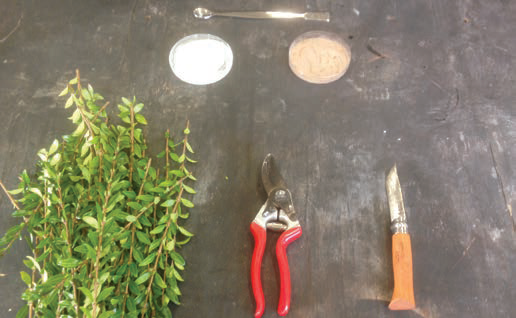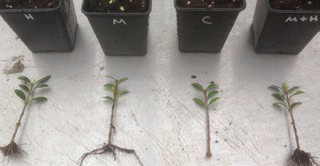As part of our continued drive to promote and communicate horticultural research conducted by Irish students, we’re delighted to share the work completed by Institute of Technology Blanchardstown student Paul Dunlea on mycorrhizal fungi
The word ‘mycorrhiza’ was originally derived from the Greek words ‘mycos’ meaning fungus and ‘rhiza’ meaning root and was first adopted in 1885 by the German researcher Albert Bernhard Frank. Mycorrhizal fungi co-evolved with the colonisation of plants on land and have remained morphologically unaltered for approximately 450 million years. It is thought that as many as 90% of all plant species now live naturally in mutualistic symbiosis with soil fungi. Symbiosis is the term used to define two or more organisms living together, with both receiving benefits from the association.
The symbiotic relationships between the plant and fungus are often referred to as mycorrhizal associations and are essential to the biology of the majority of plants within the environment. This relationship benefits both the plant and the fungus through the exchange of carbohydrates and other nutrients from the plant to the fungus while providing the plant with an enhanced capability to absorb water and nutrients.
As plants inoculated with mycorrhizal fungi are known to have greater absorption of micro and macronutrients and water, they have reduced requirements for irrigation and fertiliser application. Inoculated plants tend to be healthier and more vigorous and therefore have a greater ability to resist pathogens such as pests and diseases.
Mycorrhizal fungi are classified into two major groups: ectomycorrhizal and endomycorrhizal fungi. Ectomycorrhizal (ECM) associations make up approximately 20% of all mycorrhizal associations. ECM fungi are a group of mutualistic root symbionts that provide nutrient uptake and increased resistance to drought and stress, and in return, the fungus receives carbon from the host plant. ECM do not enter the root cells or vascular bundles, instead, the fungus penetrates the root cortex forming a sheath of septate hyphae around the entire root surface, replacing the root hairs and root cap. The hyphae form an intercellular network between the root cortex cells, known as the Hartig net, which is responsible for nutrient exchange between the fungus and plant.
Endomycorrhizal fungi, also known as arbuscular mycorrhizal fungi, are the most common type of mycorrhizal association formed by the majority of horticultural crops.
Endomycorrhizal fungi do not change the gross morphology of the host roots. During the infection process, the chlamydospores (thick-walled vegetative cells that function like a spore) in the soil germinate close to the plant roots. As they penetrate the epidermis of the roots, irregular mycelia develop between the cells of the root cortex. Hyphal coils, or peletons form within the cells of the outer cortex. As the fungus penetrates the parenchyma cortex, structures of special branched haustorium called arbuscules develop intracellularly. These arbuscules act as the site of carbon exchange to the fungus, and nutrient and water exchange to the host plant. Vesicles are either produced intracellularly or intercellularly and act as a storage structure containing lipids.
As the fungus colonises the plant’s root system, a network of branches called hyphae (long white filamentous branches of vegetative growth) is extended into the soil surrounding the plant roots. The hyphal network replaces the function of the plant’s root hairs, extends the plant’s root system and increases the plant’s ability to absorb water and additional nutrients, primarily Phosphorus and Nitrogen. In return, the fungus obtains carbohydrates and other nutrients from the plant.
As part of my undergraduate thesis in the Institute of Technology Blanchardstown, I undertook a project to determine whether using mycorrhizal fungi, rooting hormone or a combination of both was most beneficial in aiding root initiation and root development of semi-hardwood cuttings during propagation. I decided to focus my thesis on this topic as I have keen interests in the various aspects of plant propagation and the research involved in order to improve the efficiency of nursery stock production.
For the purpose of the experiment, 360 semi-hardwood cuttings of Lonicera pileata (privet honeysuckle) were prepared, divided into four groups and subjected to one of the following treatments; mycorrhizal fungi inoculum (containing both endomycorrhizal and ectomycorrhizal fungi), rooting hormone, a combination of mycorrhizal fungi inoculum and rooting hormone and the control (no treatment application). All cuttings were placed on a warm bench in a randomised block design and covered with a polythene sheet for the duration of the experiment. The purpose of the experiment was to determine which of the four treatments would provide the most positive results in terms of rooting initiation, percentage of cuttings rooted, root length, root ball diameter and fresh and dry root weights, just six weeks after initial propagation.


The rationale for the project was to assess the many benefits of incorporating mycorrhizal fungi during cutting propagation and to establish how these beneficial fungi may potentially increase the success rates and efficiency of cutting propagation in nursery stock production.
The findings of this study suggest that mycorrhizal fungi in conjunction with rooting hormone produced cuttings with the largest root system when compared to those treated with either mycorrhizal fungi or rooting hormone alone. The most significant findings of this study were observed when analysing the average fresh and dry root weight per cutting. The combined treatment of mycorrhizal fungi and rooting hormone produced cuttings with highest average fresh and dry root weights. The combined treatment resulted in a 46.94% and 20.41% increase in average fresh root weight per cutting when compared to the control and rooting hormone treatments respectively. There was also a 50% increase in average dry root weight per cutting over the control and a 19.45% increase over cuttings treated with rooting hormone alone.

When compared to the control, the treatment of mycorrhizal fungi alone achieved better results in all of the parameters tested, but overall was not as successful as the combined treatment or the treatment of rooting hormone alone.
The increased benefits of using the combined treatment could greatly aid the nursery stock industry in terms of crop productivity and the quality of the stock produced. Cuttings treated with the combination of mycorrhizal fungi and rooting hormone showed a quicker rooting response when compared to the other treatment applications, only three weeks after initial propagation. It is believed that the application of mycorrhizal fungi in combination with rooting hormone can increase root initiation for some cultivars that usually take longer to root. This increased root initiation can decrease the length of the production cycle while increasing the quality of cuttings produced. By reducing the time it takes for cuttings to root, large-scale producers could potentially yield a greater amount of stock at a faster rate and therefore increase their profits.
Although many previous studies have shown the benefits of incorporating mycorrhizal fungi into the rooting medium during cutting propagation, there has been limited research into its use when applied as a root dip to the base of semi-hardwood cuttings. The results of this study demonstrated that use of mycorrhizal fungi inoculum during the propagation of semi-hardwood cuttings has shown to increase root initiation and development when applied to the base of the cuttings prior to insertion into the rooting medium.
These findings indicate that there were increased benefits from the mycorrhizal fungi inoculum when root colonisation by the mycorrhizal fungi occurs as early as possible during root development. It is believed that the fungal inoculum should be present during the adventitious root formation of cuttings in order to achieve the greatest benefits from the
mycorrhizal fungi.
The nursery industry is currently facing increasing challenges from the introduction of government regulations restricting the use of certain fertilisers, pesticides and fungicides. As a result, there is now a greater demand to produce plants that are more resistant to environmental and biotic stresses and have reduced requirements for fertilisers, pesticides and irrigation. Another challenge facing the nursery industry is the increasing cost of irrigation and the further regulations reducing the run-off from irrigation systems. With the introduction of these government regulation and increased awareness of the harmful effects on the environment with the overuse of chemical fertilisers and pesticides, there are increasing opportunities for the utilisation of mycorrhizal fungi during propagation in large-scale nursery systems. Mycorrhizal fungi improve the plant’s health and vigour, encourage root formation and promote plant growth while reducing the need for pesticide and fertiliser applications. ✽
 Paul Dunlea recently completed his honours level degree through the BSc in Horticulture in the Institute of Technology Blanchardstown. His main interests lie in plant propagation and the research involved in order to create ecologically sustainable and efficient propagation methods. He would be very interested in carrying out further research for large-scale propagation systems in order to improve plant productivity and is currently pursuing a career in this field. Email: pauldunlea@outlook.com, Phone: 085 821 1521. Paul Dunlea recently completed his honours level degree through the BSc in Horticulture in the Institute of Technology Blanchardstown. His main interests lie in plant propagation and the research involved in order to create ecologically sustainable and efficient propagation methods. He would be very interested in carrying out further research for large-scale propagation systems in order to improve plant productivity and is currently pursuing a career in this field. Email: pauldunlea@outlook.com, Phone: 085 821 1521. |




